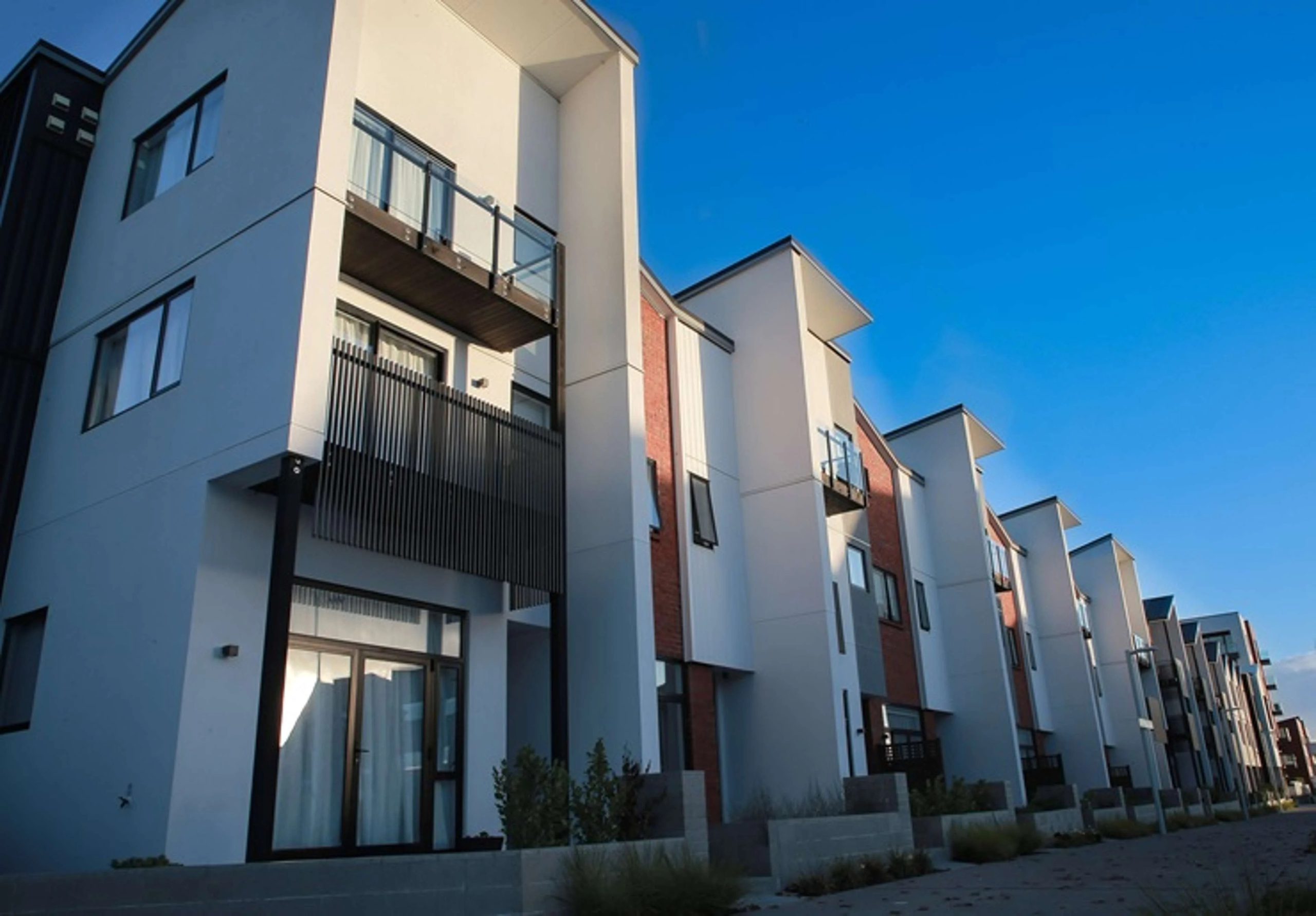【澳纽网编译】奥克兰霍布森维尔的联排别墅。该郊区是上一次房屋建设热潮的中心。摄影/迈克尔·克雷格
1. Can we build it? Yes we can
1. 我们可以建造它吗?是的,我们能
In recent years, smaller dwellings such as townhouses have typically accounted for 50-60% of all new building consents across the country, a far cry from the post-GFC figures of less than 20% over 2010-13. But in fact, that sharp upswing in the rate of construction for this more intensified type of dwelling was actually to a large extent an Auckland boom (stemming from the Unitary Plan) – with new CoreLogic figures showing that of the total change of about 39,600 in the number of flats/townhouses across NZ since 2016, nearly 25,000 have been in Auckland, or about 63% of the growth. In turn, about one-third of Auckland’s overall rise in townhouse stock has been in Waitakere (e.g. Hobsonville), with about one-quarter in Manukau, and 20% in Auckland City.
近年来,联排别墅等小型住宅通常占全国所有新建筑许可的50-60%,这与2010-13年全球金融危机后不到20%的数字相去甚远。但事实上,这种更密集的住宅类型建筑速度的急剧上升实际上在很大程度上是奥克兰的繁荣(源于统一计划)——新的CoreLogic数据显示,自2016年以来,新西兰各地公寓/联排别墅数量的总变化约为39,600套,其中近25,000套在奥克兰, 或约占增长的63%。反过来,奥克兰联排别墅存量总体增长的约三分之一来自怀塔克雷(例如霍布森维尔),约四分之一位于曼努考,20%位于奥克兰市。
广告 | Advertisement
在澳纽网做广告 | Advertise with us
In bigger picture terms, it’s a great example of what friendlier planning laws can achieve, with townhouses (and more dwellings in general) providing a different and cheaper option for a wider range of property buyers. Here’s hoping that the Government’s current, strong push on housing supply rules will have the same effect in the coming years.
从更大的角度来看,这是一个很好的例子,说明更友好的规划法可以实现什么,联排别墅(以及更多的住宅)为更广泛的购房者提供了一个不同的、更便宜的选择。希望政府目前对住房供应规则的大力推动将在未来几年产生同样的效果。
2. No moves on higher LVR lending yet
2. 目前还没有提高 LVR 贷款的举措
Given we already knew that sales volumes were low in June, it wasn’t any surprise to see gross new mortgage lending flows (house purchase, bank switches, loan top-ups) dipped $0.1 billion year-on-year. The weakness reflected a drop in lending to owner-occupiers rather than investors, although investors were hardly through the roof either. There was also no evidence that banks/borrowers acted early on higher loan-to-value ratio (LVR) lending in June (given they knew looser rules were coming from July 1). Indeed, the share of owner-occupier lending going out at <20 deposit held steady at 10%, well below the prevailing 15% speed limit, not to mention the new rule of 20%. Of course, this probably just reflects the ongoing restraint of high mortgage rates.
鉴于我们已经知道 6 月份的销售量很低,看到新抵押贷款总额(购房、银行转换、贷款充值)同比下降 1 亿纽币也就不足为奇了。这种疲软反映了对自住业主而非投资者的贷款下降,尽管投资者也几乎没有达到顶峰。也没有证据表明银行/借款人在 6 月份提前对更高的贷款价值比 (LVR) 贷款采取行动(因为他们知道从 7 月 1 日起将实施更宽松的规定)。事实上,以20<存款流出的自住业主贷款比例稳定在10%,远低于现行的15%的速度限制,更不用说20%的新规定了。当然,这可能只是反映了高抵押贷款利率的持续限制。
广告 | Advertisement
在澳纽网做广告 | Advertise with us
3. Consumers see the light?
3.消费者看到了光明吗?
ANZ’s overall consumer confidence measure rose fairly sharply in July, although the total itself is still low. The increase was driven more by the forward-looking components of the survey rather than the mood on the ground right now. In other words, it’s not great at present, but households can see better times ahead. That’s likely to reflect the now-widespread expectation that the Official Cash Rate will have started to drop before the end of the year, with some mortgage rates already falling. Adding to the good news on that front, the inflation expectations measure from ANZ’s consumer confidence survey fell further in July and is now back to its lowest level since September 2020.
澳新银行(ANZ)的整体消费者信心指数在7月份大幅上升,尽管总体本身仍然很低。这一增长更多是由调查的前瞻性部分推动的,而不是目前实时的情绪。换句话说,目前情况并不好,但家庭可以看到更好的时代。这可能反映了现在人们普遍的预期,即官方现金利率将在今年年底前开始下降,一些抵押贷款利率已经下降。除了这方面的好消息外,澳新银行消费者信心调查的通胀预期指标在 7 月份进一步下降,目前已回到 2020 年 9 月以来的最低水平。

CoreLogic chief economist Kelvin Davidson: “It’s not great at present, but households can see better times ahead.” Photo / Peter Meecham
CoreLogic首席经济学家Kelvin Davidson表示:“目前情况并不好,但家庭可以看到未来会有更好的时光。摄影 / Peter Meecham
广告
Advertise with us
4. Filled jobs start to fall?
4. 填补的工作岗位开始下降?
Later today, Stats NZ will publish the filled jobs data for June. These employment figures have really flattened off in the past few months (after a period of sustained growth), and given the obvious struggles for many firms at present, it wouldn’t be too much of a surprise to see a small drop in filled jobs in June’s data. The cooling labour market is certainly another reason to be pretty cautious about the prospects for property.
今天晚些时候,新西兰统计局将公布 6 月份的就业数据。在过去的几个月里(经过一段时间的持续增长之后),这些就业数据确实趋于平缓,鉴于目前许多公司显然都在苦苦挣扎,在6月份的数据中看到填补的职位小幅下降也就不足为奇了。劳动力市场的降温无疑是对房地产前景持谨慎态度的另一个原因。
5. Keeping an eye on ‘bad debt’
5. 密切关注“坏账”
On Wednesday, we’ll get the Reserve Bank’s June data on the stock of mortgages. There are many different breakdowns to look at, but one key aspect of this monthly dataset is the amount of non-performing housing debt sitting on the banks’ balance sheets. So far, loan repayment problems have remained very low, but it’s important to keep an eye on this measure, given that job losses have started but markedly lower mortgage rates haven’t arrived just yet.
周三,我们将获得储备银行 6 月份的抵押贷款存量数据。有许多不同的细分数据可供查看,但这个月度数据集的一个关键方面是银行资产负债表上的不良住房债务金额。到目前为止,贷款偿还问题仍然非常低,但重要的是要密切关注这一指标,因为失业已经开始,但尚未显着降低的抵押贷款利率。
– Kelvin Davidson is chief economist at property insights firm CoreLogic
来源:oneroof
分类: 澳纽资讯
(即时多来源) 新西兰英语新闻 New Zealand English News
广告 | Advertisement
在澳纽网做广告 | Advertise with us
4,220 views






